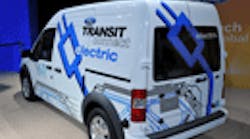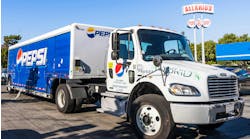Light vehicle manufacturers are introducing more hybrid and all-electric models in an effort to help them comply with more stringent Corporate Average Fuel Economy (CAFE) standards going into effect a decade and a half down the road.
Yet the challenge for light vehicle fleets now and in the future will be correctly calculating the fuel saving capability of such technology, in order to offset the higher acquisition cost of for such vehicles, according to Eric Mallia, business development manager for consulting firm FleetCarma.
“Powertrain electrification, including hybrid and ‘grid-enabled’ [plug-in hybrid and all-electric] vehicles, will be manufactured by OEMs to avoid the big penalties associated with not meeting these [CAFÉ] standards – and we’re already starting to see this reality unfold in the marketplace,” he explained to Fleet Owner.
“But what we are realizing from the early adopters of hybrids and electrics is that the potential [fuel and maintenance] savings are highly dependent on multiple drive cycle variables,” Mallia cautioned. “That means in some applications, hybrid and electric vehicles make good economic sense for fleets – but not in every and all cases. And the cost of a bad decision can be substantial.”
The new federal CAFE standards will require manufacturers of light-duty vehicles to have an average fuel economy rating on their passenger cars of 54.5 miles per gallon by 2025. That’s nearly double the efficiency required today, Mallia noted.
Although hybrid and electric vehicles are priced at a premium to their gasoline and diesel counterparts, he said, most fleet managers understand that these vehicles have the potential to offer operational savings during their service life.
“But real-world energy costs – whether petroleum or electricity – can vary greatly in the case of hybrids and electrics since the fuel economy of these vehicles are much more sensitive to duty cycles than their gasoline counterparts,” Mallia pointed out.
“As a result,” he added, “fleets are realizing they need to acquire drive-cycle data about their own specific vehicles to make better procurement decisions. Otherwise, the uncertainties of a bad decision can be too risky and too costly for their operations.”
Yet fuel price volatility is a big issue for fleets as well, so FleetCarma contends that more and more fleets will strongly consider purchasing “grid-enabled” vehicles in the near-term simply because the costs of electricity are less volatile.
That echoes the conclusions reached in a study conducted by consulting firm Pike Research back in September, which found in particular that purchases of plug-in electric vehicles (PEVs) will vary significantly by geography, with the most populous states as well as those with the highest fuel prices seeing the highest sales.
Hawaii, which typically has among the highest gas prices in the nation, will be the top state for PEV adoption, according to Pike’s study, representing 6.3% of total light-duty vehicle sales in 2017. The second highest penetration rate will be in California (5.4%), followed by Oregon (5.4%), Washington, DC (4.6%), and Delaware (4.5%).
“In the end, fleet operators will need to understand two things to make an informed decision,” said FleetCarma’s Mallia. “First, will an electric vehicle do the job in their particular application? If so, will it be cost-effective over its entire service life in their fleets? If the answer is repeatedly ‘yes’ to both of these questions, OEMs should have the ability to gain the critical mass they need in the marketplace to stay ahead of the curve and meet these aggressive future CAFE standards.”



